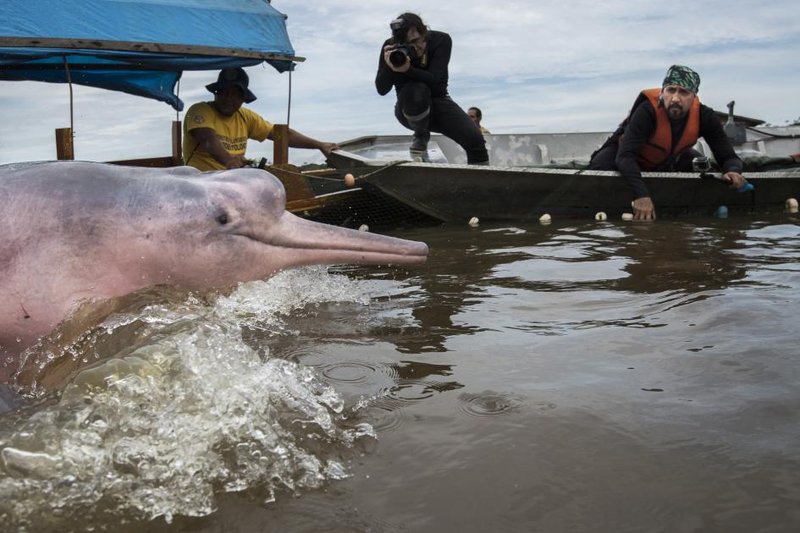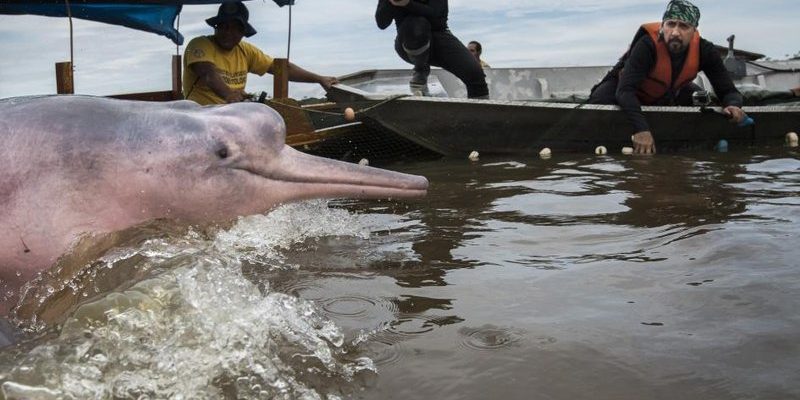
While it might sound dreamy to splash around with these dolphins, the reality is a bit more complex. The Amazon River is home to a delicate ecosystem, and the botos are part of this intricate web of life. Interacting with them isn’t just a matter of jumping in and waving; it involves understanding their behavior, habitat, and the risks present both for humans and these amazing animals. So, grab a cup of coffee, and let’s chat about how we can safely connect with the Amazon River dolphin while respecting their wild nature.
Understanding the Amazon River Dolphin
The Amazon River dolphin, or boto, is a fascinating creature that can grow up to 8.5 feet long and weigh over 400 pounds. Their distinctive pink color sets them apart from other dolphins, making them a true gem of the Amazon. Unlike their ocean-dwelling relatives, these dolphins have adapted to life in freshwater. They have a long snout that helps them hunt fish and navigate the complex waterways filled with trees and plants.
You might be wondering how these dolphins behave in the wild. Botos are generally social animals that live in small groups. They use echolocation to find food and communicate with each other. Imagine sending out little sound waves that bounce back to help you “see” your surroundings. That’s how these dolphins navigate their world! Yet, they are also known to be shy and elusive, which can make spotting and interacting with them challenging.
It’s important to note that Amazon River dolphins are classified as vulnerable due to habitat loss, pollution, and hunting. Their populations face significant threats, which is why conservation efforts are essential. Understanding their status helps us appreciate the need for protecting these magnificent beings and their environment.
Is It Safe to Interact With Botos?
When it comes to interacting with Amazon River dolphins, safety is a top priority. The short answer? It can be safe, but it requires knowledge and respect for their space. Here’s the thing: while many people have positive experiences swimming with botos in controlled environments, the river is their home, and we’re merely guests.
Direct interactions should ideally happen in the presence of trained professionals who understand dolphin behavior and can guide you through a safe experience. For instance, responsible eco-tours often prioritize the well-being of the dolphins and ensure that humans maintain a respectful distance. This allows dolphins to engage on their terms, which is crucial for their comfort and safety.
In the wild, you should always observe these dolphins rather than try to touch or swim with them. They can be unpredictable, and sudden movements can startle them. So, if you ever find yourself near these beautiful creatures, take a moment to admire them from afar. You’ll have a far richer experience watching their natural behavior without intruding.
How to Interact Responsibly
If you’re keen to have an interaction with the Amazon River dolphin, there are several responsible ways to do so. Here are some tips to ensure a safe and respectful encounter:
- Choose Responsible Tour Operators: Always go with reputable eco-tour companies that prioritize the well-being of the dolphins. Research their practices and read reviews from past participants.
- Follow Guidelines: Listen to your guides and follow their instructions. They know what’s best for the dolphins and how to keep you safe.
- Maintain Distance: Even when you’re allowed to swim with them, give the dolphins space. Observing from a distance can be just as rewarding and less stressful for the animals.
- Avoid Loud Noises: Dolphins are sensitive to sound. Keeping the noise levels down respects their environment and encourages them to come closer if they feel comfortable.
These practices not only ensure your safety but also protect the dolphins and their habitat. Here’s a little story: I once joined a responsible eco-tour where we kayaked quietly down the river. We spotted a group of botos frolicking nearby, and it was magical. We kept our voices low and simply enjoyed watching them play without intruding in their space.
The Importance of Conservation
You might be surprised to learn that the actions we take as individuals can significantly impact the Amazon River dolphin’s survival. As more people visit the Amazon for eco-tourism, it’s essential to focus on conservation. The threats to these dolphins include pollution from agricultural runoff, deforestation, and illegal fishing practices that reduce their food supply.
Conservation organizations work hard to raise awareness and implement protective measures. Supporting these organizations or participating in conservation activities can help ensure that future generations get to see and interact with these incredible creatures. It’s not just about protecting the dolphins; it’s about preserving the entire ecosystem of the Amazon River.
Imagine if everyone took a moment to consider how their actions affect the environment. Simple steps like reducing plastic use, supporting sustainable tourism, and educating others can create a ripple effect. By preserving the rivers and habitats, we create a better future not just for dolphins, but for all wildlife sharing that precious ecosystem.
Common Misconceptions About Botos
There are many myths surrounding Amazon River dolphins that can lead to misunderstandings. One common misconception is that they are aggressive or dangerous. In reality, botos are generally gentle and curious creatures. The risks come more from human actions than from the dolphins themselves.
Another myth is that you can easily spot these dolphins everywhere in the Amazon. While they are present in many areas, they tend to prefer specific habitats. Factors like water temperature, availability of food, and river depth affect where you might encounter them. Understanding their preferences can increase your chances of seeing them while respecting their natural behaviors.
Lastly, people sometimes believe that interacting with dolphins is always beneficial. While some interactions can be positive, forcing contact can stress these animals. It’s essential to prioritize their comfort and well-being over human desires for close encounters.
Having the opportunity to interact with the Amazon River dolphin is a once-in-a-lifetime experience that many people dream about. However, it’s vital to approach these beautiful creatures with respect, understanding, and care. By choosing responsible ways to interact, you not only enhance your experience but also contribute to the conservation of these unique animals and their habitat.
Remember, the key to a safe interaction lies in knowledge—about the dolphins, their environment, and how best to appreciate them from a respectful distance. As guardians of the planet, we all need to play our part in ensuring that future generations can also enjoy the allure of the Amazon River dolphin. So, the next time you think about taking that plunge into the Amazon waters, consider how you can do it responsibly and with a heart for conservation.

